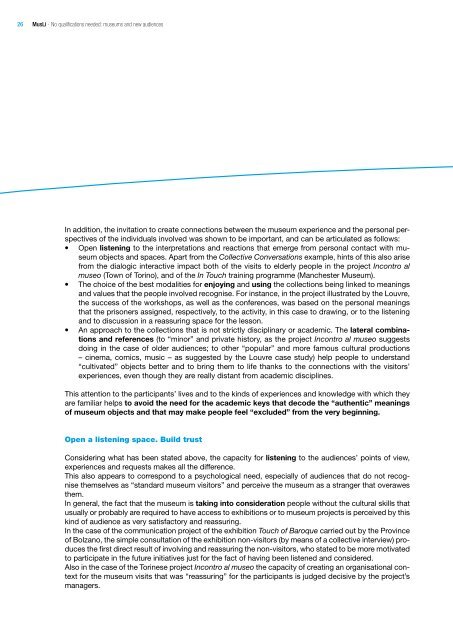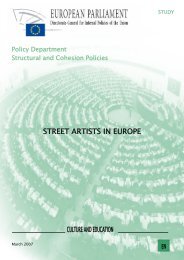MusLi (Museums Literacy) - Fondazione Fitzcarraldo
MusLi (Museums Literacy) - Fondazione Fitzcarraldo
MusLi (Museums Literacy) - Fondazione Fitzcarraldo
You also want an ePaper? Increase the reach of your titles
YUMPU automatically turns print PDFs into web optimized ePapers that Google loves.
26 <strong>MusLi</strong> - No qualifications needed: museums and new audiences<br />
In addition, the invitation to create connections between the museum experience and the personal perspectives<br />
of the individuals involved was shown to be important, and can be articulated as follows:<br />
• Open listening to the interpretations and reactions that emerge from personal contact with museum<br />
objects and spaces. Apart from the Collective Conversations example, hints of this also arise<br />
from the dialogic interactive impact both of the visits to elderly people in the project Incontro al<br />
museo (Town of Torino), and of the In Touch training programme (Manchester Museum).<br />
• The choice of the best modalities for enjoying and using the collections being linked to meanings<br />
and values that the people involved recognise. For instance, in the project illustrated by the Louvre,<br />
the success of the workshops, as well as the conferences, was based on the personal meanings<br />
that the prisoners assigned, respectively, to the activity, in this case to drawing, or to the listening<br />
and to discussion in a reassuring space for the lesson.<br />
• An approach to the collections that is not strictly disciplinary or academic. The lateral combinations<br />
and references (to “minor” and private history, as the project Incontro al museo suggests<br />
doing in the case of older audiences; to other “popular” and more famous cultural productions<br />
– cinema, comics, music – as suggested by the Louvre case study) help people to understand<br />
“cultivated” objects better and to bring them to life thanks to the connections with the visitors’<br />
experiences, even though they are really distant from academic disciplines.<br />
This attention to the participants’ lives and to the kinds of experiences and knowledge with which they<br />
are familiar helps to avoid the need for the academic keys that decode the “authentic” meanings<br />
of museum objects and that may make people feel “excluded” from the very beginning.<br />
Open a listening space. Build trust<br />
Considering what has been stated above, the capacity for listening to the audiences’ points of view,<br />
experiences and requests makes all the difference.<br />
This also appears to correspond to a psychological need, especially of audiences that do not recognise<br />
themselves as “standard museum visitors” and perceive the museum as a stranger that overawes<br />
them.<br />
In general, the fact that the museum is taking into consideration people without the cultural skills that<br />
usually or probably are required to have access to exhibitions or to museum projects is perceived by this<br />
kind of audience as very satisfactory and reassuring.<br />
In the case of the communication project of the exhibition Touch of Baroque carried out by the Province<br />
of Bolzano, the simple consultation of the exhibition non-visitors (by means of a collective interview) produces<br />
the first direct result of involving and reassuring the non-visitors, who stated to be more motivated<br />
to participate in the future initiatives just for the fact of having been listened and considered.<br />
Also in the case of the Torinese project Incontro al museo the capacity of creating an organisational context<br />
for the museum visits that was “reassuring” for the participants is judged decisive by the project’s<br />
managers.






